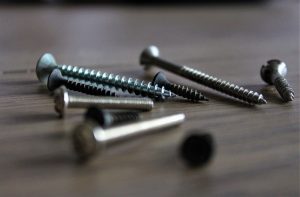
When shopping for fasteners, you’ll need to consider the drive type. Different fasteners have different drive types. The drive type, of course, refers to the shape of the recess within a fastener’s head. You’ll have to place a tool inside of this recess, followed by turning the tool, to either install or remove the fastener. While some fasteners have a cruciform drive type, others have a slotted drive type. Below are four of the most common slotted drive types for fasteners.
#1) Slot
One of the oldest and most common slotted drive types for fasteners is the slot. Fasteners with a slot drive type are designed for use with a flat-bladed or flat-headed screwdriver. They’ve been around for centuries. Even today, many screws and bolts are designed with a slot drive type. The slot drive type features a simple pattern consisting of a single horizontal line that forms the recess. You can place the tip of a flat-bladed screwdriver into this recess, followed by turning it to install or remove the fastener.
#2) Cross
Another common slotted drive type for fasteners is the cross. Also known as the double-slot drive type, it lives up to its namesake by featuring an intersecting horizontal and vertical line. It’s essentially the same as the slot drive type, except the cross drive type has a vertical line running through the center of the horizontal line. These two lines form a cross. Like with the slot drive type, the cross drive type supports the use of a flat-bladed screwdriver. It just has two recesses where you can insert a flat-bladed screwdriver. If one of the recesses or “lines” becomes stripped, you can insert a flat-bladed screwdriver into the other recess.
#3) Coin Slot
Some fasteners have a coin slot drive type. It’s not as common as the slot or cross drive type. From afar, the coin slot drive recess may look the same as the slot drive recess. Both types of drive recesses feature a single horizontal line. The difference between them is that the slot drive type has a uniform depth throughout the line, whereas the coin slot drive type has a tapered depth. In other words, the line becomes deeper towards the middle from the sides.
#4) Hi-Torque
The least common slotted drive type is hi-torque. The hi-torque drive type is designed for fastening applications that require a substantial amount of torque. It features a canonical-shaped recess that supports the tip of a tool bit. This canonical shape allows for more torque than that of other slotted drive types.
